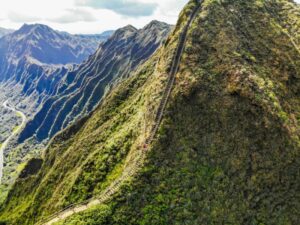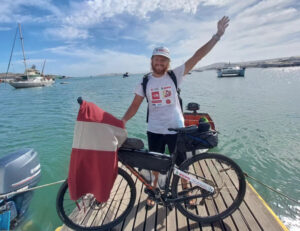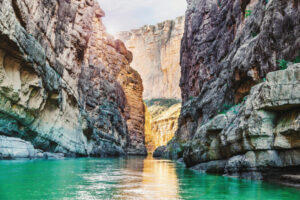With Piotr Chmielinski reporting for Pythom/Explorersweb about the current Amazon adventurers, rewind 30+ years to get a glimpse of how he and others changed river running. This article was originally published in Canoe & Kayak Magazine.
(Canoe & Kayak, words: Tyler Williams, photos: Zbigniew Bzdak)
Peru’s Colca River Canyon ends abruptly, where ramparts of hard Andean rock plunge into the earth. It is a fitting finale to the world’s deepest canyon, a place of raw beauty where condors soar like silent bombers and 1,000-foot waterfalls are commonplace. Descending the Colca is a Class V challenge demanding flawless equipment, technical precision, and meticulous planning. The first group of paddlers to explore it had none of those things.
In June 1981, seven famished Polish adventurers paddled through the Colca’s dramatic granite gates, marking the completion of a historic first descent. The men, who called themselves the Canoandes (Canoe + Andes) did not revel in their accomplishment. They had entered the canyon 11 days before, carrying provisions for just five days. Finding food at the nearest village was their first priority, and after dozens of similar adventures in Mexico and Central America, they knew the drill: Shrug off the pangs of hunger, and paddle onward.
Such toughness was ingrained in the Canoandes, a shifting team of paddlers born of the Byztre Kayak club in the late 1970s, when Poland was in thrall to the Soviet Empire. The Byztre club was the place where a complete novice could learn how to make his own sprayskirt, and then use it on a river the next week. The outings provided sanctuary from the watchful eyes of government apparatchiks who lurked everywhere.
“That club was like an island. It gave us a sense of freedom,” club president Andrezj Pietowski recalls. Byztre’s inclusive philosophy attracted more than 400 members, and that popularity earned some clout within the strict organizational hierarchy of the communist government.
To get anything done in Poland in 1978 required finagling one’s way through layers of bureaucracy, building bridges at every step until finally, if luck and the proper officials smiled upon you, the golden goose might offer an egg. Pietowski and club organizer Piotr Chmielinski were masters at navigating the system, so when a paddling trip to Argentina was proposed, sponsorship was simply a matter of connecting the kayak club to the student club, to the national youth club, to the central communist committee.
In the name of international relations, the central committee offered the Argentina-bound paddlers coveted travel visas, and issued them a six-wheeled military supply truck. Weighing 12,000 pounds, and with a top speed of 35 mph, the vehicle looked more like a tank than a shuttle rig.
The Canoandes were thrilled.
The expedition team attracted the most free-spirited paddlers in Poland, men in their mid-20s with either military service or marriage on the doorstep. The opportunity to travel abroad—to run rivers in exotic, sultry South America, no less—was as irresistible as it was rare.
Chmielinski approached Zbigniew Bzdak in a college dormitory, and their conversation was typical of Canoandes recruitment.
“Do you want to go to Argentina?”
“Maybe, when do we leave?”
“In two days.”
“Okay then.”
The team included a shuttle driver, a physician, and a couple of the Byztre club’s hottest paddlers. They numbered 10 in all, among them cinematographer Jacek Bogucki and Bzdak, a still photographer. The cameramen had hardly held paddles before, but their government sponsors insisted they document the trip. The photographers would learn river running on the fly.
They weren’t far behind the others. Only three of the 10 could safely manage Class IV, and most had very marginal kayak rolls. Still, with 10 people, 21 kayaks (fiberglass boats broke, so they brought spares), and one map, the Canoandes were off—to Mexico.
If the Canoandes were anything, they were flexible. While the team was preparing in Poland, Argentina and Chile had come to the brink of war over disputed territory. The Canoandes hatched a Plan B for Peru, but political tensions soon arose there too. Mexico was their Plan C, and the Canoandes embraced it. Though it wasn’t immediately apparent, the change turned out to be a blessing. Their first river foray in Mexico was on the Rio Pescados, now a popular Class III-IV rafting excursion for tourists from Mexico City. In 1979, at high water, it was a sobering reality check for the would-be explorers. There were swims upon swims, and at the end of the day seven of their 21 kayaks were broken or missing.
The river had humbled them. The expedition was crumbling. They weren’t even on the right continent. But the ever-optimistic Poles adapted their objectives and pushed onward. Tierra del Fuego was now a long ways off, but the Grand Canyon of the Colorado was within striking distance. With funds dwindling but hopes high, they entered the United States as winter approached, seeking support from a fellow countryman. Chris Chmura, a Byztre club paddler, had emigrated to Casper, Wyoming, a few years earlier. The massive shuttle rig soon rolled into town, prompting the local paper to headline “Polish invade Casper.”
The Canoandes were open, friendly, genuine, and hard-working—qualities that endeared them to locals throughout their travels, beginning in Casper. Most of them found work by painting houses, others strung barbed-wire fences on windswept ranchland, a valued job during winter in Wyoming. At night they cooked communally, and crashed in Chmura’s basement.
By late winter, their ledgers were again in the black, and it was time to go boating. A message had arrived from Poland in the meantime, however. It was the Bureau, and they wanted their truck back. It was to be shipped out of Veracruz, Mexico, as soon as possible. Via telegram, the crafty Canoandes bought a little more time. They would proceed to Veracruz, but they had a few stops along the way. Paddling the Andes remained merely a dream.
In February, the 10 travelers left Casper bound for the Grand Canyon, via Las Vegas. Even in Vegas, the six-ton Polish camper made an impression. As the machine crept out of town on a desert highway, a car sped up from behind and flashed its lights. A troupe of Polish acrobats had spotted their country’s flag on the big rig as it cruised the Strip, and chased it down. The next thing the Canoandes knew, they were backstage, heads spinning among topless girls on skates.
The Las Vegas detour was more than just a good party. When the acrobats learned of the paddlers’ need for a new vehicle, they gave them one. It was a Chevy pickup, serendipitously titled a Cheyenne after the Wyoming capital, and it went faster than 35 mph.
Driving two vehicles now, the group began to distill into two, those who would return to Poland with the military truck, and those who would retool for an overland push to long-sought South America. The Grand Canyon turned out to be a bust due to permit restrictions, and Mexico’s Copper Canyon, their next objective, was too low to float when they arrived. They finally got on the water in central Mexico, at the Santa Maria.
Nobody knew that this river would become Mexico’s classic. The Canoandes simply picked it off the map—a squiggly blue line that ran through a blank spot on their road atlas. The Poles’ planning process did not include satellite photos, topographic maps, guidebooks, or even word of mouth recommendations. Communist Poland was light-years from today’s wireless digital age. They had obtained a map of Argentina, perhaps the only one in Poland, from a Polish rally-car driver who had competed there, and it was a prize. Although important achievements were happening in whitewater—the Everest Dudh Kosi expedition and film, Holbek and company exploring California, Germany’s Alpine Kanu Club steep-creeking in Corsica—the insulated Poles were aware of none of it. They had little exposure to the wider whitewater world, and were learning on their own. As Piotr explains, “I learned by being beaten on the head by the river, many times.”
One of those beatings came on the Santa Maria. The team had purchased a raft in the States so they could include the non-kayakers of the group, but they knew nothing about the art of raft rigging. When the boat flipped on Day Two of the six-day trip, most of their food drifted away. Arduous portaging on minimal rations ensued, a trial that would cause most expeditions to disintegrate. The Canoandes gritted through without argument, and reveled in their good fortune when they found a catfish trapped in a backwater on the fifth day. They caught it barehanded and shared it 10 ways.
Solidarity was more than a slogan for the labor movement blossoming in their homeland, it was a trait shared between the Polish people, and intensified within the Canoandes. After half the group returned to Europe with the monster truck, a gang of five remained in Mexico, led by Andrezj and Piotr, who were the perfect compliments. Piotr could start a friendly conversation with anybody, and he was very organized. Andrezj spoke the best Spanish, and he played guitar, often strumming a popular Mexican tune as his backup band chimed in. Jacek, the diminutive movie cameraman, boomed an unexpectedly deep baritone. All sang with endearing Eastern European accents. There was a popular skit on Saturday Night Live at the time with Steve Martin and Dan Akroyd as unabashed Czech swingers, self proclaimed “wild and crazy guys.” The Canoandes were the real life incarnation, and the world couldn’t help but embrace them. As Canoande Stefan Danielski says, “We approached people with open hearts and the world opened to us.”
In Mexico City, the Polish ambassador—a misfit within the stodgy communist regime, thus his assignment in far away Mexico—felt their bond immediately. He arranged a meeting between the Canoandes and Mexico’s vice president. Soon the Polish paddlers were exotic foreign guests at a wedding of Mexican royalty, where funding for their river explorations was discussed. Out of a wedding party haze, the Andes began to morph back into focus.
The Canoandes weren’t getting by solely on charm. Every river they ran was recorded in thorough detail, from access points to water levels to scenic value. Professional photography accompanied every report. When they presented their findings to Mexico’s tourism chief, he responded with a $10,000 check and an official letter of support, signed by the vice president’s brother. With that, the Canoandes continued south.
image: https://stwww.canoekayak.com/files/2013/03/cakp120800pg46_1.jpg
Piotr Chmielinski writes in his diary.
Piotr Chmielinski writes in his diary in a cave at the bottom of Colca Canyon.
They rolled into Guatemala and stopped for a kayaking television spot (Polish invade Guatemala!), drove across Honduras and paddled Nicaragua’s Rio Matagalpa at high water, where Andrezj took a long swim. When they reached Costa Rica, he was relegated to a hotel bed from a kidney infection while the rest of the group paddled the then-unknown Pacuare. Commercial rafting pioneer Michael Kaye, their escort, got lost on the way to the Reventazon, and they wound up launching on the Pacuare instead. Whether or not Kaye schemed the wrong turn remains a mystery, but the crew laid down a first descent of the landmark run nonetheless. “We weren’t ready for that yet,” Piotr says of the Pacuare’s whitewater. But they were close. It had been more than a year since the Poles arrived in the Americas with intermediate skills, and by now they were developing some real whitewater chops.
They ran more rivers in Panama, crossed the canal, and continued south toward their continent of dreams—all the way to the end of the road. They hadn’t bargained on the Darien Gap, an impenetrable strip of jungle separating Central and South America. Even now, there is no road through this frontier wilderness of jaguars, smugglers, and swamps. The Canoandes blithely penetrated the Darien expecting to enter Colombia. Fortunately the road expired before their good fortune did, and they made a U-turn for Panama City.
Hurdles like this repeatedly erupted in their path, and the Canoandes cleared each of them in their inimitable style. A friend at the consulate in Panama arranged passage on a Polish freighter bound for Ecuador. Once there, they were detained at the customs harbor until a deposit was secured for their American truck. After two weeks, a fellow Pole with contacts and money bailed them out. At the tense Peruvian border, lines of vehicles waited to be searched and interrogated. The Canoandes cruised through unmolested, their signed Mexican letter opening the gates.
The whole time we try to get to Argentina. This is good because otherwise we’d have stopped somewhere nice,” says Piotr. Instead, the Canoandes eddied out for weeks at a time, exploring the most spectacular rivers of Latin America at each turn before surrendering to the gravitational pull southward. Their final big detour led to the Andes of Peru.
Here are the highest tributaries of the world’s biggest river, many of which figured prominently in the Amazon’s unsolved geographic puzzle. The Canoandes had a keen sense of that exploration history, and sought rivers that were integral to the reconstruction of the continent. The Maranon, a major fork of the Amazon with many miles of moderate, high-volume whitewater, was their first stop in Peru, and it was a huge success—no broken boats and not a single day without food. The Urubamba, another Amazon tributary, runs below Machu Picchu. The Canoandes ran the river and toured the ruins. But their crowning river seemed to find the Canoandes as much as they found it. A smallish desert waterway quietly wending to a lonely Pacific coastline, the Colca turned out to be rich with history and mystery.
A U.S. military pilot first reported the lost Colca valley in the 1920s. National Geographic sent a reconnaissance team in the ‘30s. A German scholar compiled a report on the region in the ‘50s, and in the ‘60s a Peruvian professor named Reparasz suggested the river “might be navigable by experts.” That was just the nudge the Canoandes needed.
At their core the Canoandes were still a ragtag group of river-runners, but they were able to present themselves as international explorers with an impressive resume of descents. In Lima, as in Mexico City, the Polish consulate led them to the tourism minister, who happened to know Mr. Colca himself, Professor Reparasz. The Canoandes stopped by for dinner. “I’m telling you, impossible things happen,” says Andrezj.
Now in possession of the best information available, they began the first descent of what soon would be recognized as the deepest canyon on the planet. Their raft was top-quality. Everything else was not. Specialized river gear was available in 1981—polypropylene insulation, plastic kayaks—but the Canoandes didn’t have any of it. Their paddles were cheap and wooden, their helmets were for hockey, their life jackets were cumbersome Mae-West models, and their clothing was hypothermia-inducing cotton. But their resolve was second to none, and the Canoandes marched into the upper Colca canyon ready for a five-day challenge. They emerged after an 11-day battle.
Andrezj pinned and broke his kayak. The raft flipped. The canyon pinched down to closeout horizon lines, forcing sketchy scouting climbs and sketchier must-run drops. Rockfall was prevalent. The entire group was dangerously chilled for most of the trip, and true to form, they ran out of food. Still, they emerged intact.
They continued south, running rivers and eventually reached long-sought Argentina and Tierra del Fuego. But their journey had one more chapter. Returning north, they arrived back in Peru in late 1981. Already celebrities for their Colca triumph, they also drew great attention in Peru because they were Polish. The showdown between Lech Walesa’s Solidarity movement and Poland’s communist regime had captured headlines around the world. On December 13, 1981, the Polish government declared martial law. The Canoandes reacted by organizing a pro-Solidarity march through the streets of Lima. They spoke out in the Peruvian press, and arranged a fundraising piano concert with an expatriate maestro.
The government in Poland was not pleased. Friends at the Polish consulate in Lima quietly warned them to stay away—implying that Warsaw had issued orders for their arrest. Their Peruvian visas were about to expire. They were trapped.
They resolved to return overland to the U.S., but that bought them little time. Their travel documents allowed them just 45 days in the States. Again, a new friend intervened on their behalf. A member of the U.S. embassy staff in Lima crafted an official letter stating that the Canoandes were en route to a Grand Canyon expedition. The document bought them a six-month American stay. The extra time was all they needed. A few migrated to Canada. The others returned to Casper, where they again made a splash, networked their way to Senator Alan Simpson, and eventually gained political asylum.
Members of the Canoandes would return four more times to the bottom of Colca Canyon—twice in 1983 for an unpublished National Geographic story and film project, in 1985 to search for Peruvian friends lost in the canyon, and again for National Geographic in 1991. Following the 1985 expedition, Piotr made the first source-to-sea descent of the Amazon with American journalist Joe Kane.
There was life after Canoandes too, and their individual successes speak volumes on the group’s character. Today there is a TV producer, a chief engineer on a freighter, an accomplished photojournalist, a teacher and a businessman. Even more impressive is the bond that the Canoandes still share. They meet annually on the Potomac River near Washington, D.C., for a weekend paddle and barbeque. Thirty years after their Colca glory, the important things haven’t changed. There, after 11 days of cold and wet and hunger, they emerged as they entered, synchronously working to a shared goal, an icon of solidarity.
Read more at https://www.canoekayak.com/canoe/canoandes/#DIIZbEIoYbEZvIXq.99
Previous on Pythom:
Piotr Chmielinski, Godfather of Amazon exploration (Interview Part 1 of 3)
Christmas and Holidays on the Amazon! Part 5
“}






